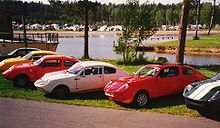Marcos Cars
Marcos Cars is a former British manufacturer of sports cars and kit cars .
history
The company was founded in 1959 by Jeremy Marsh and Frank Costin in Luton . The two company founders combined the first syllables of their surnames Mar sh and Cos tin to form Marcos .
Frank Costin had previously worked on De Havilland DH.98 Mosquito fighter-bombers and had the idea of using plywood for frames in automotive engineering. The plant moved to Bradford on Avon, Wiltshire , England in 1963 and to a factory near Westbury in 1971 .
Problems with exporting the vehicles to the USA and the move led to financial bottlenecks in the 1970s and finally to the business closure. But Marsh stayed in the automotive business, bought back the naming rights to Marcos in 1976 and dared to restart in 1981 with the Marcos V6 Coupé, which was sold as a kit for self-assembly.
Marcos went bankrupt again in 2000 , but has been building cars again since 2002 thanks to Canadian Tony Stelliga who bought the company. While road vehicles were manufactured in Kenilworth ( Warwickshire , England), racing car production was relocated to Zwaagdijk in the Netherlands . On October 9, 2007, it was announced that vehicle production would cease and the company would be liquidated. The situation on the market was assessed in such a way that sufficient profits cannot be achieved.
Models
Marcos presented many different models, including Marcos GT (1960/61), Marcos 1000GT Gullwing (1961/62), Marcos Fastback GT (1963/64), Marcos 1800GT (from 1964), 1500GT, 3Liter, Marcos Mantaray, Marcos Mantis , Marcos Mantis GT, Marcos LM500, Marcos LM 600, Marcos Mantara Spyder 400, Marcos Mantula, Mini Marcos, Marcos TSO GT2, Marcos TSO-GT Coupe, Marcos TSO.
Marcos GT
The first Marcos, the Marcos Xylon from 1959, was an unusual car with gull-wing doors, front wheels and a four-part windshield. Frank Costin was solely responsible for the construction , who for the first time implemented his idea of a plywood monocoque in racing car construction. The production vehicle (1961) was only less radical compared to the prototype, but had front wheels covered with a hood and internal headlights under Plexiglas covers. After only seven copies and Costin's departure from the Marcos project, the body shape was revised to a more pleasing appearance under the leadership of the Adams brothers, the plywood chassis was now designed even more radically for lightweight construction without subframes for the engine, front and rear axles. From this vehicle, the Luton Gullwing, 13 vehicles were built, which were mainly used in national and international motorsport.
In 1962 , Marcos competed in the Le Mans 24 Hours for the first time . The Luton Gullwing Coupe with drivers John Hine / Dick Prior, powered by a 1.5 liter Ford Martin 12-valve engine, had to be parked in the 9th hour with engine failure (oil pressure).
From 1963, there was an orientation towards vehicles that were a little more roadworthy, which was to be achieved with the Fastback GT model. With 18 Fastback units produced, this attempt was unsuccessful, however, the more successful it was in international motorsport, as Marco's factory racing cars were now used more frequently on the mainland (including two factory cars at the Nürburgring 500 km race in 1963). The vehicles were optionally powered by engines between 997 cm³ and 1498 cm³, which came from Ford England ( Ford Anglia and Cortina ). Motors prepared by Cosworth or Martin were preferably used in competition cars. Steering and chassis components came from the Standard 10 as well as from the Triumph Herald. A total of 18 vehicles of this model had been produced by 1964.
The Marcos 1800 premiered at the London Motor Show in January 1964. A completely new design, the tried and tested plywood chassis, which, however, had to be completely redesigned, and a robust Volvo engine were the cornerstones for the now more successful entry into series production of a sports car, the further development of which continued into the 1990s. It was not until 1969 that the production of the plywood chassis was stopped because the extremely time-consuming production was no longer profitable and the small company was ruined. As a replacement, the Adams brothers developed a robust, but very conventional tubular space frame, onto which the tried and tested fiberglass body was now screwed.
Individual evidence
- ↑ Marcos Engineering Appoints Administrator
- ^ Marcos folds ( Memento from October 20, 2007 in the Internet Archive )






